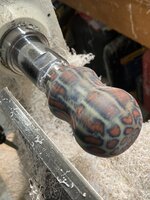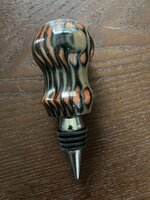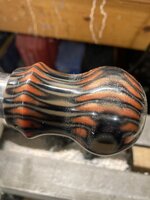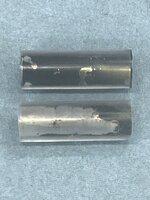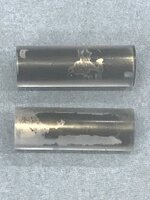frankonthetis
Member
Made my first batch of 8 stabilized blanks from spalted Cascara, Dogwood & Big Leaf Maple Sept 5. These blanks were cut to size in 2017 and stored indoors. Baked for approx. 5 hours at 220F then into Cactus Juice vacuum setup for 10 hours, some tiny bubbles still evident, vacuum released then soaked for another 36 hours. Baked finished blanks in toaster oven for 4 hours at 220F and there was crystallized juice on blanks and drip pan where they sat on the oven rack, no wet spots. Overall weight of individual blanks had increased anywhere from 40 to 60% after process.
Yesterday, sized one Cascara blank for a Groove Click pen, drilled 7mm holes then glued tubes in with thick CA glue. Noticed when drilling that it was a very fine dust/sawdust that was produced by the bit. Non-stabilized blanks produce either chips or curls when being drilled out.
Today turned the blank to size with a roughing gouge then skew. Both tools also produced this dust like output that clung to them similar to how the acrylic blank shavings stick. A small chunk of wood broke off at the nib end but it was just proud of the bushings. When doing the final sizing for middle section of the clip end at the middle bushings that area just disintegrated to expose the barrel. That was very disappointing as same thing happens to me with spalted wood that has no stabilizing.
Questions are;
1. is this fine dust output when drilling or shaping normal? 2. any obvious errors in my preparations/procedures? 3. should the stabilized blanks be left for x time before use?
Thanks in advance for any suggestions, critiques or hints. Invested heavily in the stabilizing system so would really like to make it work.
Frank
Yesterday, sized one Cascara blank for a Groove Click pen, drilled 7mm holes then glued tubes in with thick CA glue. Noticed when drilling that it was a very fine dust/sawdust that was produced by the bit. Non-stabilized blanks produce either chips or curls when being drilled out.
Today turned the blank to size with a roughing gouge then skew. Both tools also produced this dust like output that clung to them similar to how the acrylic blank shavings stick. A small chunk of wood broke off at the nib end but it was just proud of the bushings. When doing the final sizing for middle section of the clip end at the middle bushings that area just disintegrated to expose the barrel. That was very disappointing as same thing happens to me with spalted wood that has no stabilizing.
Questions are;
1. is this fine dust output when drilling or shaping normal? 2. any obvious errors in my preparations/procedures? 3. should the stabilized blanks be left for x time before use?
Thanks in advance for any suggestions, critiques or hints. Invested heavily in the stabilizing system so would really like to make it work.
Frank

